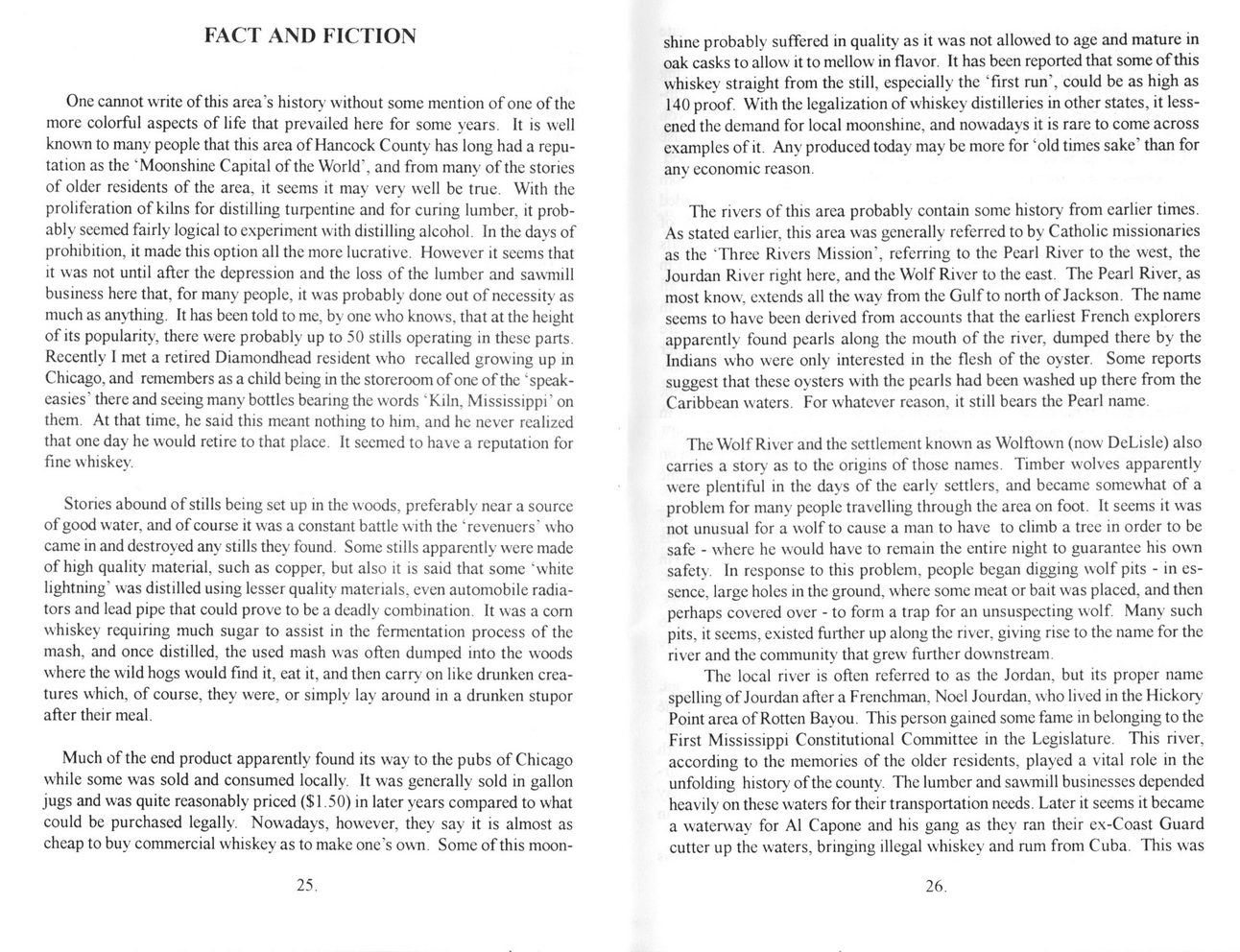This text was obtained via automated optical character recognition.
It has not been edited and may therefore contain several errors.
FACT AND FICTION One cannot write of this area?s history without some mention of one of the more colorful aspects of life that prevailed here for some years. It is well known to many people that this area of Hancock County has long had a reputation as the ?Moonshine Capital of the World7, and from many of the stories of older residents of the area, it seems it may very well be true. With the proliferation of kilns for distilling turpentine and for curing lumber, it probably seemed fairly logical to experiment with distilling alcohol. In the days of prohibition, it made this option all the more lucrative. However it seems that it was not until after the depression and the loss of the lumber and sawmill business here that, for many people, it was probably done out of necessity as much as anything. It has been told to me, by one who knows, that at the height of its popularity, there were probably up to 50 stills operating in these parts. Recently I met a retired Diamondhead resident who recalled growing up in Chicago, and remembers as a child being in the storeroom of one of the ?speakeasies? there and seeing many bottles bearing the words ?Kiln, Mississippi? on them. At that time, he said this meant nothing to him, and he never realized that one day he would retire to that place. It seemed to have a reputation for fine w hiskey. Stories abound of stills being set up in the woods, preferably near a source of good water, and of course it was a constant battle with the ?revenuers? who came in and destroyed any stills they found. Some stills apparently w'ere made of high quality material, such as copper, but also it is said that some ?white lightning? was distilled using lesser quality materials, even automobile radiators and lead pipe that could prove to be a deadly combination. It was a com whiskey requiring much sugar to assist in the fermentation process of the mash, and once distilled, the used mash was often dumped into the woods where the wild hogs would find it, eat it, and then carry on like drunken creatures which, of course, they were, or simply lay around in a drunken stupor after their meal. Much of the end product apparently found its way to the pubs of Chicago while some was sold and consumed locally. It was generally sold in gallon jugs and was quite reasonably priced ($1.50) in later years compared to what could be purchased legally. Nowadays, however, they say it is almost as cheap to buy commercial whiskey as to make one?s own. Some of this moon- 25. shine probably suffered in quality as it was not allowed to age and mature in oak casks to allow it to mellow in flavor. It has been reported that some of this whiskey straight from the still, especially the ?first run?, could be as high as 140 proof. With the legalization of whiskey distilleries in other states, it lessened the demand for local moonshine, and nowadays it is rare to come across examples of it. Any produced today may be more for ?old times sake? than for any economic reason. The rivers of this area probably contain some history from earlier times. As stated earlier, this area was generally referred to by Catholic missionaries as the ?Three Rivers Mission?, referring to the Pearl River to the west, the Jourdan River right here, and the Wolf River to the east. The Pearl River, as most know, extends all the wav from the Gulf to north of Jackson. The name seems to have been derived from accounts that the earliest French explorers apparently found pearls along the mouth of the river, dumped there by the Indians who were only interested in the flesh of the oyster. Some reports suggest that these oysters with the pearls had been washed up there from the Caribbean waters. For whatever reason, it still bears the Pearl name. The Wolf River and the settlement known as Wolftown (now DeLisle) also carries a story as to the origins of those names. Timber wolves apparently were plentiful in the days of the early settlers, and became somewhat of a problem for many people travelling through the area on foot. It seems it was not unusual for a wolf to cause a man to have to climb a tree in order to be safe - where he would have to remain the entire night to guarantee his own safety. In response to this problem, people began digging wolf pits - in essence, large holes in the ground, where some meat or bait was placed, and then perhaps covered over - to form a trap for an unsuspecting wolf. Many such pits, it seems, existed further up along the river, giving rise to the name for the river and the community that grew further downstream. The local river is often referred to as the Jordan, but its proper name spelling of Jourdan after a Frenchman, Noel Jourdan, w ho lived in the Hickory Point area of Rotten Bayou. This person gained some fame in belonging to the First Mississippi Constitutional Committee in the Legislature. This river, according to the memories of the older residents, played a vital role in the unfolding history of the county. The lumber and sawmill businesses depended heavily on these waters for their transportation needs. Later it seems it became a waterway for A1 Capone and his gang as they ran their ex-Coast Guard cutter up the waters, bringing illegal whiskey and rum from Cuba. This was 26.

Annunciation Church Kiln 017